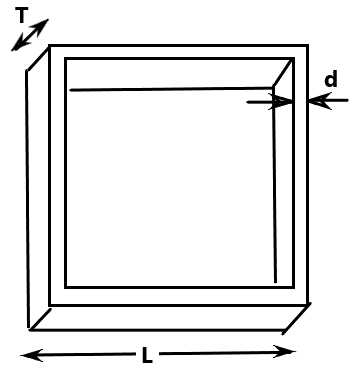A square loop is cut out of a thick sheet of aluminum. It is then placed so that the top portion is in a uniform magnetic field B directed into the page, and is allowed to fall under gravity. Assume that the loop reaches terminal velocity before it is entirely out of the magnetic field. In the diagram, shading indicates the field region. a) Find an algebraic solution for the terminal velocity. b) Find an algebraic solution for the velocity as a function of time. c) Plot the velocity as a function of time for a magnetic field of 1 T. Tell me where you get any values that you look up. Note: This is what I would call a "messy physics problem". You are not given all the values that you need nor is it specified exactly which quantities your algebraic solution may contain. Your algebraic solution should contain only quantities that are given in the problem and quantities that could be reasonably looked up in a table (like Table 14.1 in Volume 1 of your text, that you haven't necessarily seen but might, just might, be helpful). In particular, your solutions should not include the dimensions of the loop.
A square loop is cut out of a thick sheet of aluminum. It is then placed so that the top portion is in a uniform magnetic field B directed into the page, and is allowed to fall under gravity. Assume that the loop reaches terminal velocity before it is entirely out of the magnetic field. In the diagram, shading indicates the field region. a) Find an algebraic solution for the terminal velocity. b) Find an algebraic solution for the velocity as a function of time. c) Plot the velocity as a function of time for a magnetic field of 1 T. Tell me where you get any values that you look up. Note: This is what I would call a "messy physics problem". You are not given all the values that you need nor is it specified exactly which quantities your algebraic solution may contain. Your algebraic solution should contain only quantities that are given in the problem and quantities that could be reasonably looked up in a table (like Table 14.1 in Volume 1 of your text, that you haven't necessarily seen but might, just might, be helpful). In particular, your solutions should not include the dimensions of the loop.
Related questions
Question

Transcribed Image Text:A square loop is cut out of a thick sheet of aluminum. It is then placed so that the top portion is in
a uniform magnetic field B directed into the page, and is allowed to fall under gravity. Assume
that the loop reaches terminal velocity before it is entirely out of the magnetic field. In the diagram,
shading indicates the field region.
a) Find an algebraic solution for the terminal velocity.
b) Find an algebraic solution for the velocity as a function of time.
c) Plot the velocity as a function of time for a magnetic field of 1 T. Tell me where you get
any values that you look up.
Note: This is what I would call a "messy physics problem". You are not given all the values that
you need nor is it specified exactly which quantities your algebraic solution may contain. Your
algebraic solution should contain only quantities that are given in the problem and quantities that
could be reasonably looked up in a table (like Table 14.1 in Volume 1 of your text, that you haven't
necessarily seen but might, just might, be helpful). In particular, your solutions should not include
the dimensions of the loop.
Expert Solution
Step 1

Trending now
This is a popular solution!
Step by step
Solved in 4 steps with 4 images
